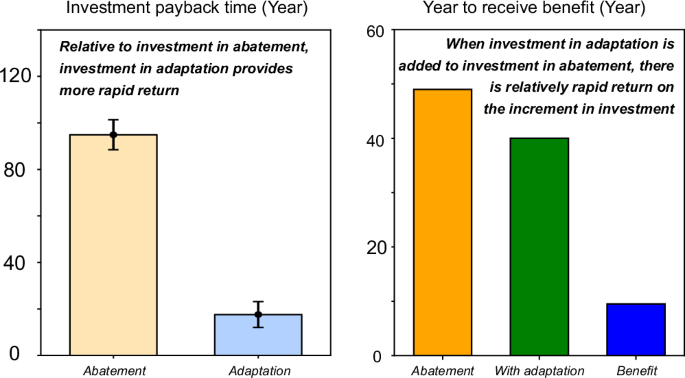- EIB fears ‘reputational disaster’ over revised EU green reporting
- Elon Musk Accused Of Bullying Republicans To Scrap US-China Investment Safeguards To Protect Tesla’s Interests
- Here’s How Much a $1000 Investment in Workday Made 10 Years Ago Would Be Worth Today
- Apple’s $1 Billion Investment Is ‘Not Sufficient,’ Says Indonesia’s Industry Minister, As Company Tries To Reach Deal To Lift iPhone 16 Sales Ban As Quickly As Possible
- Gold prices are climbing once again. What gold assets should I invest in now?
IPCC. Climate Change 2022: Impacts, Adaptation and Vulnerability. Contribution of Working Group II to the Sixth Assessment Report of the Intergovernmental Panel on Climate Change [H.-O. Pörtner et al. Rama (Eds.)] (2022).
You are viewing: Near-term benefits from investment in climate adaptation complement long-term economic returns from emissions reduction
Hall, N. & Persson, Å. Global climate adaptation governance: why is it not legally binding? Eur. J. Int. Relat. 24, 540–566 (2018).
Grafakos, S. et al. Integration of mitigation and adaptation in urban climate change action plans in Europe: a systematic assessment. Renew. Sustain. Energy Rev. 121, 109623 (2020).
Sharifi, A. Trade-offs and conflicts between urban climate change mitigation and adaptation measures: a literature review. J. Clean. Prod. 276, 122813 (2020).
Shi, L. & Moser, S. Transformative climate adaptation in the United States: trends and prospects. Science 372, eabc8054 (2021).
Howarth, C. & Robinson, E. J. Z. Effective climate action must integrate climate adaptation and mitigation. Nat. Clim. Change 14, 300–301 (2024).
Jakob, M. & Steckel, J. C. Implications of climate change mitigation for sustainable development. Environ. Res. Lett. 11, 104010 (2016).
Kyriakopoulos, G. L. & Sebos, I. Enhancing climate neutrality and resilience through coordinated climate action: Review of the synergies between mitigation and adaptation actions. Climate 11, 105 (2023).
Martinich, J. & Crimmins, A. Climate damages and adaptation potential across diverse sectors of the United States. Nat. Clim. Change 9, 397–404 (2019).
Becher, O. et al. The challenge of closing the climate adaptation gap for water supply utilities. Commun. Earth Environ. 5, 1–13 (2024).
Villamayor-Tomas, S. et al. Developing countries can adapt to climate change effectively using nature-based solutions. Commun. Earth Environ. 5, 1–11 (2024).
Dottori, F., Mentaschi, L., Bianchi, A., Alfieri, L. & Feyen, L. Cost-effective adaptation strategies to rising river flood risk in Europe. Nat. Clim. change 13, 196–202 (2023).
Stewart, M. G., Wang, X. & Nguyen, M. N. Climate change adaptation for corrosion control of concrete infrastructure. Struct. Saf. 35, 29–39 (2012).
Chen, S. et al. Adaptation strategy can ensure seed and food production with improving water and nitrogen use efficiency under climate change. Earth’s Future 11, e2022EF002879 (2023).
Pavanello, F. et al. Air-conditioning and the adaptation cooling deficit in emerging economies. Nat. Commun. 12, 6460 (2021).
Hemmati, M., Kornhuber, K. & Kruczkiewicz, A. Enhanced urban adaptation efforts needed to counter rising extreme rainfall risks. NPJ Urban Sustain. 2, 1–5 (2022).
Nik, V. M., Perera, A. T. D. & Chen, D. Towards climate resilient urban energy systems: a review. Natl Sci. Rev. 8, nwaa134 (2021).
Paukert, C. et al. Climate change effects on North American fish and fisheries to inform adaptation strategies. Fisheries 46, 449–464 (2021).
Buhl, M. & Markolf, S. A review of emerging strategies for incorporating climate change considerations into infrastructure planning, design, and decision making. Sustain. Resil. Infrastruct. 8, 157–169 (2023).
Sarkodie, S. A., Ahmed, M. Y. & Owusu, P. A. Global adaptation readiness and income mitigate sectoral climate change vulnerabilities. Humanit. Soc. Sci. Commun. 9, 1–17 (2022).
See more : Leading sustainable investment for a transitioning world :: Environmental Finance
Araos, M. et al. Equity in human adaptation-related responses: a systematic global review. One Earth 4, 1454–1467 (2021).
Zhao, M. & Boll, J. Adaptation of water resources management under climate change. Front. Water 4, 983228 (2022).
Wilson, K. L., Tittensor, D. P., Worm, B. & Lotze, H. K. Incorporating climate change adaptation into marine protected area planning. Glob. Change Biol. 26, 3251–3267 (2020).
Shakou, L. M., Wybo, J.-L., Reniers, G. & Boustras, G. Developing an innovative framework for enhancing the resilience of critical infrastructure to climate change. Saf. Sci. 118, 364–378 (2019).
de Bruin, K., Dellink, R. & Agrawala, S. Economic Aspects of Adaptation to Climate Change: Integrated Assessment Modelling of Adaptation Costs and Benefits. https://www.oecd-ilibrary.org/environment/economic-aspects-of-adaptation-to-climate-change_225282538105, (2009).
de Bruin, K. C., Dellink, R. B. & Tol, R. S. J. A. D.- DICE: an implementation of adaptation in the DICE model. Clim. Change 95, 63–81 (2009).
Bosello, F., Carraro, C. & de Cian, E. Climate policy and the optimal balance between mitigation, adaptation and unavoided damage. Clim. Change Econ. 01, 71–92 (2010).
Agrawala, S. et al. Plan or react? Analysis of adaptation costs and benefits using integrated assessment models. Clim. Change Econ. 02, 175–208 (2011).
Bosello, F., Carraro, C. & De Cian, E. Adaptation can help mitigation: an integrated approach to post-2012 climate policy. Environ. Dev. Econ. 18, 270–290 (2013).
Estrada, F., Tol, R. S. J. & Botzen, W. J. W. Extending integrated assessment models′ damage functions to include adaptation and dynamic sensitivity. Environ. Model. Softw. 121, 104504 (2019).
Markandya, A., De Cian, E., Drouet, L., Polanco-Martínez, J. M. & Bosello, F. Building risk into the mitigation/adaptation decisions simulated by integrated assessment models. Environ. Resour. Econ. 74, 1687–1721 (2019).
Bastien-Olvera, B. A. & Moore, F. C. Use and non-use value of nature and the social cost of carbon. Nat. Sustain. 4, 101–108 (2020).
Carlino, A., Tavoni, M. & Castelletti, A. Self‐adaptive multi‐objective climate policies align mitigation and adaptation strategies. Earth’s Future 10, e2022EF002767 (2022).
Zemel, A. Adaptation, mitigation and risk: an analytic approach. J. Econ. Dyn. Control 51, 133–147 (2015).
Ayong Le Kama, A. & Pommeret, A. Supplementing domestic mitigation and adaptation with emissions reduction abroad to face climate change. Environ. Resour. Econ. 68, 875–891 (2017).
Nozawa, W., Tamaki, T. & Managi, S. On analytical models of optimal mixture of mitigation and adaptation investment. J. Clean. Prod. 186, 57–67 (2018).
Farnham, M. & Kennedy, P. Adapting to climate change: equilibrium welfare implications for large and small economies. Environ. Resour. Econ. 61, 345–363 (2015).
Finus, M., Furini, F. & Rohrer, A. V. The efficacy of international environmental agreements when adaptation matters: Nash-Cournot vs Stackelberg leadership. J. Environ. Econ. Manag. 109, 102461 (2021).
Tebaldi, C. & Friedlingstein, P. Delayed detection of climate mitigation benefits due to climate inertia and variability. Proc. Natl Acad. Sci. 110, 17229–17234 (2013).
Samset, B., Fuglestvedt, J. & Lund, M. Delayed emergence of a global temperature response after emission mitigation. Nat. Commun. 11, 3261 (2020).
Caldeira, K., Duan, L. & Moreno-Cruz, J. The value of reducing the Green Premium: cost-saving innovation, emissions abatement, and climate goals. Environ. Res. Lett. 18, 104051 (2023).
Barrage, L. & Nordhaus, W. Policies, projections, and the social cost of carbon: results from the DICE-2023 model. Proc. Natl Acad. Sci. 121, e2312030121 (2024).
See more : 2025 Tech Investment Predictions: Transformation And Realignment
Duan, L., Carlino, A. & Caldeira, K. Dataset for the paper “Combining near-term benefits of climate adaptation with long-term benefits of emissions abatement.” Zenodo (2024).
Bahn, O., Bruin, Kde & Fertel, C. Will adaptation delay the transition to clean energy systems? An analysis with AD-MERGE. Energy J. 40, 207–234 (2019).
Willner, S. N., Glanemann, N. & Levermann, A. Investment incentive reduced by climate damages can be restored by optimal policy. Nat. Commun. 12, 3245 (2021).
Kates, R. W., Colten, C. E., Laska, S. & Leatherman, S. P. Reconstruction of New Orleans after Hurricane Katrina: a research perspective. Proc. Natl Acad. Sci. 103, 14653–14660 (2006).
Hinkel, J. et al. Coastal flood damage and adaptation costs under 21st century sea-level rise. Proc. Natl Acad. Sci. 111, 3292–3297 (2014).
Brown, P. T., Moreno-Cruz, J. & Caldeira, K. Break-even year: a concept for understanding intergenerational trade-offs in climate change mitigation policy. Environ. Res. Commun. 2, 095002 (2020).
Lesnikowski, A. C., Ford, J. D., Berrang-Ford, L., Barrera, M. & Heymann, J. How are we adapting to climate change? A global assessment. Mitig. Adapt. Strateg. Glob. change 20, 277–293 (2015).
Donatti, C. I., Harvey, C. A., Hole, D., Panfil, S. N. & Schurman, H. Indicators to measure the climate change adaptation outcomes of ecosystem-based adaptation. Clim. Change 158, 413–433 (2020).
Hirschfeld, D. et al. Global survey shows planners use widely varying sea-level rise projections for coastal adaptation. Commun. Earth Environ. 4, 102 (2023).
Lu, S. & Nakhmurina, A. Financial constraints and short-term planning are linked to flood risk adaptation gaps in US cities. Commun. Earth Environ. 5, 1–13 (2024).
Barr, R., Fankhauser, S. & Hamilton, K. Adaptation investments: a resource allocation framework. Mitig. Adapt. Strateg. Glob. change 15, 843–858 (2010).
Nordhaus, W. Projections and Uncertainties about Climate Change in an Era of Minimal Climate Policies. Am. Econ. J. Econ. Policy 10, 333–360 (2018).
IPCC. in Climate Change 2023: Synthesis Report. Contribution of Working Groups I, II and III to the Sixth Assessment Report of the Intergovernmental Panel on Climate Change (eds Core Writing Team, Lee, H. & Romero, J.) 1–34 (IPCC, 2023).
Armstrong McKay, D. I. et al. Exceeding 1.5 °C global warming could trigger multiple climate tipping points. Science 377, eabn7950 (2022).
Malek, Ž., Loeffen, M., Feurer, M. & Verburg, P. H. Regional disparities in impacts of climate extremes require targeted adaptation of Fairtrade supply chains. One Earth 5, 917–931 (2022).
Lee, S., Paavola, J. & Dessai, S. Towards a deeper understanding of barriers to national climate change adaptation policy: a systematic review. Clim. Risk Manag. 35, 100414 (2022).
Berrang-Ford, L. et al. A systematic global stocktake of evidence on human adaptation to climate change. Nat. Clim. Change 11, 989–1000 (2021).
Canales, N., Klein, R. J. T., Bakhtaoui, I. & Macura, B. Assessing adaptation progress for the global stocktake. Nat. Clim. Change 13, 413–414 (2023).
Adger, W. N., Barnett, J., Brown, K., Marshall, N. & O’Brien, K. Cultural dimensions of climate change impacts and adaptation. Nat. Clim. Change 3, 112–117 (2013).
Fedele, G., Donatti, C. I., Harvey, C. A., Hannah, L. & Hole, D. G. Transformative adaptation to climate change for sustainable social-ecological systems. Environ. Sci. Policy 101, 116–125 (2019).
Smith, J. F. Using return on investment and resiliency return on investment for preparedness. Public Adm. Rev. 84, 213–217 (2023).
IPCC. Climate Change 2014: Mitigation of Climate Change. Contribution of Working Group III to the Fifth Assessment Report of the Intergovernmental Panel on Climate Change [Edenhofer, O. et al. (Eds.)] (2015).
Source: https://magnacumlaude.store
Category: News

